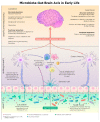Priming for Life: Early Life Nutrition and the Microbiota-Gut-Brain Axis
- PMID: 33525617
- PMCID: PMC7912058
- DOI: 10.3390/nu13020423
Priming for Life: Early Life Nutrition and the Microbiota-Gut-Brain Axis
Abstract
Microbes colonize the human body during the first moments of life and coexist with the host throughout the lifespan. Intestinal microbiota and their metabolites aid in the programming of important bodily systems such as the immune and the central nervous system during critical temporal windows of development, with possible structural and functional implications throughout the lifespan. These critical developmental windows perinatally (during the first 1000 days) are susceptible timepoints for insults that can endure long lasting effects on the microbiota-gut-brain axis. Environmental and parental factors like host genetics, mental health, nutrition, delivery and feeding mode, exposure to antibiotics, immune activation and microbiota composition antenatally, are all factors that are able to modulate the microbiota composition of mother and infant and may thus regulate important bodily functions. Among all these factors, early life nutrition plays a pivotal role in perinatal programming and in the modulation of offspring microbiota from birth throughout lifespan. This review aims to present current data on the impact of early life nutrition and microbiota priming of important bodily systems and all the factors influencing the microbial coexistence with the host during early life development.
Keywords: brain development; breast milk; early life; infant formula; microbiota-gut-brain axis; nutrition.
Conflict of interest statement
J.F.C. has been an invited speaker at meetings organized by Cátedra ORDESA-University of Granada, Neuropharmex, Mead Johnson, Friesland Campina, has been a consultant for Nestle & Alkermes and has received research funding from Mead Johnson, Cremo, Suntory Wellness, Nutricia and 4D Pharma.
Figures



References
-
- Dominguez-Bello M.G., Costello E.K., Contreras M., Magris M., Hidalgo G., Fierer N., Knight R. Delivery mode shapes the acquisition and structure of the initial microbiota across multiple body habitats in newborns. Proc. Natl. Acad. Sci. USA. 2010;107:11971–11975. doi: 10.1073/pnas.1002601107. - DOI - PMC - PubMed
-
- Milani C., Duranti S., Bottacini F., Casey E., Turroni F., Mahony J., Belzer C., Palacio S.D., Montes S.A., Mancabelli L., et al. The First Microbial Colonizers of the Human Gut: Composition, Activities, and Health Implications of the Infant Gut Microbiota. Microbiol. Mol. Biol. Rev. 2017;81:e00036-17. doi: 10.1128/MMBR.00036-17. - DOI - PMC - PubMed
-
- Pannaraj P.S., Li F., Cerini C., Bender J.M., Yang S., Rollie A., Adisetiyo H., Zabih S., Lincez P.J., Bittinger K., et al. Association Between Breast Milk Bacterial Communities and Establishment and Development of the Infant Gut Microbiome. JAMA Pediatr. 2017;171:647–654. doi: 10.1001/jamapediatrics.2017.0378. - DOI - PMC - PubMed
Publication types
MeSH terms
LinkOut - more resources
Full Text Sources
Other Literature Sources

